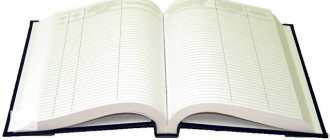5 / 5 ( 1 voice )
When an organization has developed more than three occupational safety instructions, the question of taking them into account arises. They need to be reviewed periodically (at least once every 5 years), changes made and constantly updated. Each of these actions registers a log of occupational safety instructions - we’ll talk about what it looks like, how often entries should be made in it and how it needs to be formatted in this article, and at the end of it you can download a file with log sheets for your own print.
How to register a log of occupational safety instructions
The logbook of occupational safety instructions is drawn up in the form of an A4 format stationery book. The cover of the journal contains the name of the organization, the name of the division (if any), as well as the start and end dates of the journal. The form of the journal itself is proposed in Appendix N9 to the Methodological Recommendations for the development of state regulatory requirements for labor protection, approved by Resolution of the Ministry of Labor of Russia of December 17, 2002 N80 and is freely available. For your convenience, we provide the form of this log right here, and below is a link so that you can download the log of occupational safety instructions (template).
Logbook for recording occupational safety instructions Compiled in accordance with the Methodological Recommendations, Appendix 9.
| № | date | Name of instructions | Approval date | Designation (number) | Planned inspection period | FULL NAME. employee who did the accounting | Signature of the employee who performed the accounting |
| 1 | 2 | 3 | 4 | 5 | 6 | 7 | 8 |
How to lace and number correctly
Due to rational stitching, papers are subject to systematization. In addition, the likelihood of their substitution, counterfeiting, damage or loss is reduced. For firmware and numbering, standard rules of the state standard GOST are used.
- Despite the lack of clear instructions in the legislation, one should rely on the individual requirements of the organization.
- You should familiarize yourself with general tips for organizing the systematization of documents that may be useful for carrying out procedures.
- Firmware in multi-page documentation is carried out using a classic needle and thick thread.
- For stitching, bank twine, ordinary stitching threads or Mylar tape are used.
- You need to start the process by preparing holes (3-4 pieces) in the sheets using a hole punch.
- First, the needle is inserted into the middle hole, and then the thread is distributed to the sides - above and below relative to the middle hole.
- After each “cycle” you need to return to the middle. It is best to use a dual firmware scheme.
- When the process is completed, the needle and thread are inserted into the central hole and brought out to the “wrong” side of the bound papers. The remaining tip is tied with a knot.
Magazines must be correctly numbered. Classic standards used:
- numbers are written on the leaves in Arabic using a simple pencil, in ascending order, as in books and ordinary magazines;
- the number is indicated at the top right, while the text of the document remains untouched;
- numbering of attachments is carried out within the framework of the general procedure, and as for auxiliary letters, the number is affixed to the envelope and only after that - on the sheets;
- if a document is presented in several volumes, they are numbered separately;
- applications that are separated into a separate volume are also subject to separate numbers.
Types of instructions and frequency of their recording in the journal
There are several types of labor protection instructions. First of all, these are standard (also industry-specific) instructions
— they are developed for the industry as a whole, based on the specifics of individual production. In addition to them, there are local (or local) instructions on labor protection - they are compiled for specific working professions (positions) and types of work. The latter are used in organizations as necessary local documentation on labor protection: they should be taken into account in the log.
Basic Numbering Principles
The rules for numbering orders in personnel records are not fixed anywhere. The organization has the right to determine for itself what principles to use for numbering. However, there is a generally accepted procedure that most businesses follow.
The order number, as a rule, consists of numbers - the serial number of the order and a letter code - an index indicating the type of document and (or) its shelf life. The index is added to numbers using a slash, hyphen or other symbol.
Examples of indexes include:
- “ls” - orders for personnel;
- “p” - about hiring;
- “y” - about termination of the employment contract;
- “k” - about the appointment of a business trip, etc.
Orders relating to the main activities of an enterprise are usually numbered using only numbers, indexes are not used, however, an organization can also use a letter code, and no one can prohibit it from doing so.
Numbers are assigned to orders in chronological order, starting with number 1. Each year, numbering starts from the beginning. The exception is educational and cultural institutions - in them the beginning of the year for office work purposes is September 1. This numbering simplifies the solution of issues related to searching and storing orders.
The order numbering of orders adopted in the organization must be enshrined in the regulations on personnel records management or in the order of the manager on the introduction of the appropriate procedure.
How to fill out a log of occupational safety instructions
So, any revision of the labor protection instructions is accompanied by an entry in the log of labor protection instructions. Let's figure out how to do this - we will provide recommendations for filling out the items corresponding to the columns of the journal.
- A serial number of the record is assigned.
- The date the changes were made is displayed.
- The name of the instruction is indicated.
- The date of approval of the instruction is set. (exactly the date when the instructions were first approved)
- The instruction number is indicated. (consistent numbering is maintained for all instructions)
- The scheduled inspection period is set. (5 years are added to the date of amendments)
- The full name of the employee who performed the accounting is indicated. (responsible for labor protection or full-time labor protection specialist).
- The entry is endorsed by the signature of the employee who made the records.
Numbering of sheets in the registration journal, which page to number from?
It was me, an ignoramus, who wrote it incorrectly. Tell me, are sheets or pages numbered in the safety magazine?
In theory there should be sheets, because when filling out at the end we write numbered. so many sheets. But in practice I saw that each page is numbered. Tell me how to do it correctly? The sheets are numbered. But if you need to (in particular, when investigating an accident), make a copy of the page with the employee’s signature.
The procedure for preparing and transferring cases to the archives of the Federal Service for State Registration, Cadastre and Cartography (Appendix No. 3 to the Order of the Federal Service for State Registration, Cadastre and Cartography dated December 25, 2014
N P/637) Order of the Judicial Department at the Supreme Court of the Russian Federation dated October 09, 2014 N 219
“On approval of the Instructions for office work in military courts”
The procedure for familiarizing yourself with the case materials at the Moscow OFAS Russia (Appendix to the order of the Moscow OFAS Russia dated November 18, 2008
You can download or view a list of my publications (with active hyperlinks to most of them)
Business Innovation Agency
An employer's key obligation is to ensure employee safety. Within the framework of Art. 212 of the Labor Code of the Russian Federation it is noted that there is a certain list of responsibilities in terms of maintaining documents necessary to inform personnel about basic regulatory requirements. Therefore, each company must have a personally developed system and rational procedure in relation to record keeping.
Activities begin immediately after employment and must be completed during the first working month. The development of programs is carried out on the basis of industry, nature of work, and working conditions. The complete list is approved by the management team.
Recommendations for preparing accounting and registration logs:
Numbering of sheets.
All journal sheets are numbered in the upper right corner, starting from the second. The numbering of sheets in files is necessary to secure the order in which documents are arranged after stitching (lacing) to ensure their safety. It is necessary to number all sheets in the file, except for the inventory. If the document file contains an envelope with enclosed sheets, then number the envelope first, then each enclosed sheet in turn. Blank sheets of paper are removed from the case (without damaging the integrity of the case) and destroyed. The sheets are numbered in pencil from top to bottom in ascending order of numbers, starting from the first. The numbers are placed in the upper right corner of the sheet, without affecting the text of the documents. The internal inventory sheets are numbered separately.
Firmware of documents
The numbered sheets are stitched with strong thread using two or three punctures. In the left margin (half of the free margin, in order to preserve the readability of the document texts when flipping through the file) of a multi-page document, holes are made with a needle or an awl, or all pages are punched with a hole punch at the same level. It is best to stitch documents using a piercing needle with bank twine or LS stitching threads -210. If you don’t have such a thread, you can use a strong (nylon or regular, folded several times) thread. Documents are usually stitched twice - for reliability. The ends of the thread are tied in a knot and brought to the back of the last numbered sheet. You need to leave about 5 - 6 cm of free end.
The case should be sealed with a paper sticker with an inscription.
The sticker with the certification inscription can have dimensions of approximately 4 by 5 - 6 cm. Glue the sheet so that it covers the knot and part of the length of the threads. The ends of the threads must be free. The certification is signed after the glue has dried. example: In this magazine, 50 (fifty) sheets are numbered, laced and sealed. It is signed by the head of the organization or a person authorized by him. The manager's signature must be clear and legible. The seal must be located both on the sticker with the certification inscription and on the sheet. The seal impression, located both on the sticker and on the document sheet, as well as the knot and threads filled with glue, serve to indicate the integrity of the document.
List of documents
To record documents of certain categories of permanent and temporary (over 10 years) storage, the recording of which is caused by the specifics of this documentation (especially valuable, personal files, files with restricted access documents, etc.), an internal inventory of case documents is compiled. The inventory is not numbered and must contain the following data: name of the document, date of compilation of the inventory, title (possibly with an annotation - for what purposes the set of documents is intended), a listing of all filed documents indicating the number of sheets, surname, position and signature of the inventory compiler.
- After the last registration entry (when the journal has ended), the employee responsible for office work makes an entry (without quotes), for example: 128 documents from N 1 to N 129 are registered in this journal. Number 33 is omitted. Then the position is indicated, the official’s signature is affixed and its decoding;
- All registration logs at the end of the year are handed over to the archives with other documents, and from the beginning of the new calendar year new logs are started.
These recommendations are of a general nature. When preparing personnel documentation, the employer should take into account special rules for the preparation of journals and books, the maintenance of which is classified as mandatory by law.
Logbook for issuing labor safety instructions: what is recorded in the document
- Place numbering on all sheets on one side.
- Make 2 or 3 through holes on the inner margins with an awl, only the cover is not affected.
- Then the thread and needle are threaded through the holes several times, but the threads should not be tightened too much.
- The book should be opened in the middle and the threads should be aligned so as not to complicate the use of documents.
- The two ends of the threads must be brought to the last sheet of the magazine, securing them with a knot.
- After this, you need to prepare a small white rectangle, where lacing and numbering are indicated. Everything is then sealed together.
- The number of pages is recorded on paper, including in capital letters.
- It is mandatory to indicate the full name and position of the person responsible for this.
- You need to glue the rectangle onto the threads so that their tips are visible on the other side.
- At the end, a stamp is placed, which should cover the last page.
Occupational safety logs will allow you to keep instructions in order. They will be used to track who and when the documents were provided, and who needs new copies. The presence of the book may be required during an inspection by the labor inspectorate. If it is absent, it is usually recommended to start one.
We recommend reading: 130 of the Criminal Code of the Russian Federation insult






